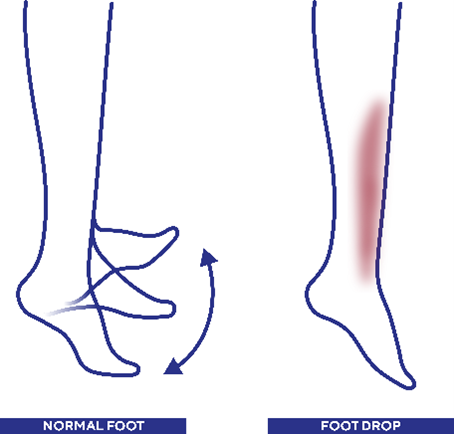Foot drop syndrome: symptoms, causes and treatment

Foot drop or high steppage gait, a weakness of the foot's dorsiflexor muscles that prevents safe and efficient walking
Foot drop syndrome, also known as a high steppage gait, is a symptom that affects the mobility of the foot. A sufferer experiences difficulty, or even an inability, to lift their foot when walking because of abnormal weakness in the muscles responsible for flexing the foot (also known as the dorsiflexor muscles). The result is that the foot systematically points towards the ground and it is difficult (if not impossible) to lift it. This can lead to issues of tripping, increased falls or catching to foot when walking, the patient will often make compensatory movements to allow the foot to clear, making the gait pattern worse. For more information on compensatory movements, see our article " Deepening on foot drop: Abnormal Gait Cycle due to Foot drop and Different methods of compensation: steppage, … ".
Foot drop is not a disease, but a symptom often caused by a neurological problem or degenerative pathology and can affect anyone temporarily or permanently.
What are causes of foot drop?
Foot drop is not a disease. It is the result of weakness or paralysis of the muscles that lift the front of the foot. It can be the result of very different pathologies or traumatic events 2, 3, 5 :
Nervous system dysfunction (stroke, multiple sclerosis, etc.)
- Foot drop can sometimes be caused by diabetes-related nerve damage, known as neuropathy.
- Hereditary conditions such as Charcot-Marie-Tooth disease can also sometimes lead to foot drop.
- Foot drop can also be caused by conditions that affect the brain or spinal cord, such as: stroke; cerebral palsy; multiple sclerosis (MS), ...
Muscular system dysfunction, muscle weakness (muscular dystrophy...)
- Muscular dystrophy is a group of hereditary genetic diseases that cause progressive muscle weakness and can sometimes lead to foot drop.
- Foot drop can also be caused by other muscle wasting conditions, such as spinal muscular atrophy or motor neurone disease.
Following trauma (severed nerve, etc.)
- Foot drop is often caused by crushing (compression) of the nerve that controls the muscles that lift the foot.
- Sometimes the nerves around the knee or lower spine can become trapped. Nerves in the leg can also be injured or damaged during joint replacement surgery.
How is a foot drop treated?
Treatments 1, 3, 4 for foot drop will depend on the origin of the symptom, whether neurological, muscular or traumatic. Whatever the treatment, the aim remains the same: to enable the patient to regain maximum mobility and help them to lift their foot. Here's what you can expect:
- Exercises
Initially carried out with the help of a health professional (a physiotherapist, for example), these exercises help to strengthen the leg muscles to improve walking movement. (See our article: What exercises should be used for foot drop?)
- Orthopaedic devices
There are many different designs of orthopaedic devices to correct foot drop: these can vary in the material they are made from (fabric, plastic or carbon fiber) and the mode of action by which they lift the foot. They can be placed internal to the shoe or external to the shoe and in most cases will travel up the leg to provide maximum control and comfort) These devices most commonly referred to as AFOs (ankle foot orthoses) make walking more natural and improve balance (see our article: The foot lift, an ally in correcting foot drop);
- Nerve stimulation
The damaged nerve is stimulated by sending small, low-voltage electrical impulses to restore the transmission of information: this is known as Functional Electric Stimulation (FES).
- Surgery
May be an alternative in some cases, to transfer muscles or tendons or even free a pinched nerve. Only a health professional will be able to advise on the most appropriate treatment.
Only a healthcare professional will be able to advise on the most appropriate treatment.
Who should be consulted about foot drop?
If you suspect you have a foot drop, there are a number of healthcare professionals who can be consulted.
- A general practitioner may be the first point of contact and can refer you to a specialist if necessary.
- A neurologist is often consulted to identify a possible neurological origin of the symptom.
- An orthopedic surgeon specializes in treating the musculoskeletal system (consisting of bones, joints, ligaments, tendons, muscles and nerves). He may be called in to assess a muscular or bone-related cause.
- An orthotist specialises in the provision of orthoses. He can supply and install AFOs under a doctor's prescription.
- A podiatrist specialises in foot disorders may also be a good option.
- Finally, a physiotherapist is often involved as part of the treatment plan to help improve mobility and strength in the leg.